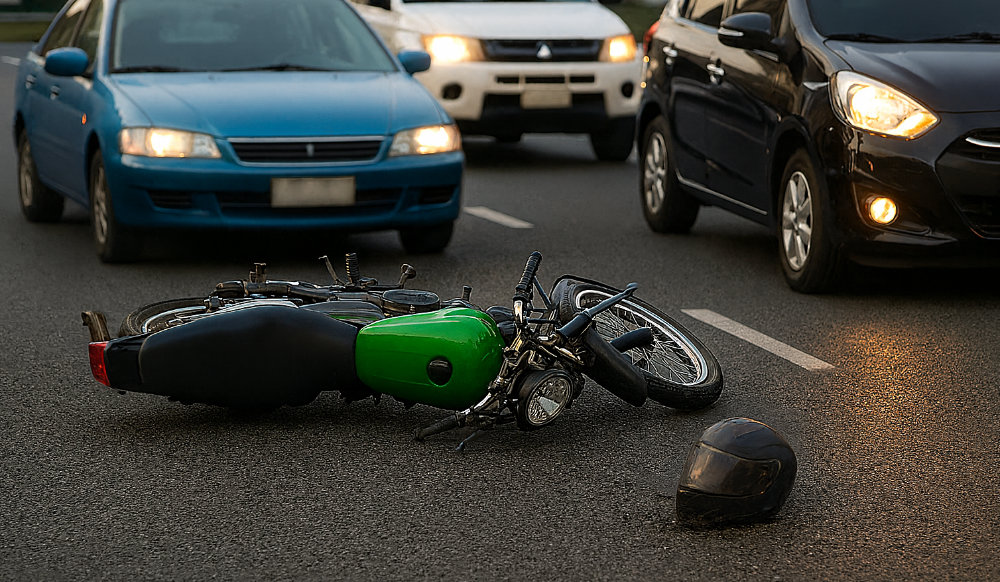
After a motor vehicle accident, the liable party pays the damages. Yet, how do you know who is at fault? At Hauptman, O’Brien, Wolf & Lathrop, LLC, our attorneys want you to find the answers that matter.
Determining liability is complex, but our experienced law team is ready to help. Keep reading to learn more about liability in motorcycle accidents, or contact us. During your free consultation with the legal team of Hauptman, O’Brien, Wolf & Lathrop, LLC, you can learn more about the resources we offer our clients.
What Are the Causes of No-Contact Motorcycle Accidents?
In no-contact motorcycle accidents, the bike doesn’t even touch the other vehicle. These accidents often happen in response to something external. In response, the rider is forced to take sudden action.
Even though no impact occurs, the crashes can lead to serious injury and legal questions. What are the causes?
The following section will discuss some of the most common factors of no-contact motorcycle accidents. Only by understanding the cause can you determine who is responsible for your damages.
Mechanical Failure
Motorcycles are sophisticated machinery with dozens of parts necessary to work correctly. Mechanical failure refers to a component’s sudden or unforeseen breakdown.
What happens when motorcycle parts are unable to perform their intended functions? The bike might not respond as its rider expects. The biker could lose the ability to steer or stop.
Common equipment malfunctions include:
- Brake failure: The vehicle’s brakes do not allow the rider to slow or stop when needed
- Tire blowouts: A tire blowout occurs when a tire bursts and loses air, making steering and stopping difficult
- Engine failure: Defective parts, such as timing belts, oil pumps, or fuel system components, may prevent the engine from running
- Throttle problems: Since the throttle controls how much air and fuel go into the engine, malfunctions can cause unexpected acceleration, deceleration, or a lack of response when the driver presses the gas pedal
- Clutch problems: Clutch problems happen when riders cannot change gears smoothly, often causing the bike to stall or vibrate
Riders should regularly inspect and maintain their bikes to lower the risk of a breakdown. Yet, even with routine maintenance, a defective part can still cause an accident. An auto parts manufacturer or repair shop may sometimes be responsible for the failure.
Road Conditions
Poor or unexpected road conditions can lead to a no-contact motorcycle crash if the surface causes the rider to lose control. These hazards often appear too fast for a safe reaction.
Common road hazards include:
- Loose gravel or sand
- Potholes
- Broken or uneven pavement
- Wet or slick surfaces
- Debris or obstacles in the road
- Missing warning signs for construction or hazards
- Broken or missing lights, road signs, signals, or markings
Government agencies or contractors are often responsible for maintaining roads. If a known hazard was left unaddressed, you can hold them accountable.
Motorist Mistakes
Another driver can cause a no-contact accident when his or her actions force the motorcyclist to react suddenly. For example, a motorist might suddenly change lanes without signaling or pull out of driveways or side roads without checking if the coast is clear.
The rider might:
- Veer off the road
- Loose balance or lay the bike down
- Turn quickly, switch lanes, or slam on the brakes to avoid a collision
- Fall when braking or swerving too sharply
- Skid or crash into a fixed object, another vehicle, or a pedestrian
Although the other drivers may never stop or even notice, they can still be held legally responsible. These cases are often complex and require prompt investigation to preserve evidence.
Why No-Contact Motorcycle Accidents Cause Serious Injuries
Motorcycles represent just 3 percent of all registered vehicles. Yet, in 2023, motorcyclists accounted for 15.5 percent of all traffic fatalities. Protective gear and helmets can protect riders only to a certain extent.
Some of the most common resulting injuries are:
- Road rash: This abrasion injury occurs when the rider’s skin rubs hard against a surface, exposing skin, muscle, and bone, causing muscle damage in the worst cases
- Broken bones: Common fracture sites are the skull, pelvis, and limbs
- Traumatic brain injuries (TBIs): TBIs can occur when jolts or blows to the head disrupt brain function, causing memory and cognition problems, dizziness, or lack of consciousness
- Spinal cord injuries: Injuries to the vertebrae can cause paralysis, incontinence, sexual dysfunction, nerve damage, and spasms
- Psychological conditions: Post-traumatic stress disorder, anxiety, phobia, and other emotional and mental conditions can result from accident trauma
Some factors contributing to motorcycle accidents are out of the rider’s control. Unlike cars, motorcycles don’t have the protection of seatbelts and car frames. You must identify the liable party if you were injured due to someone’s negligence.
How to Determine Liability for a Crash
Liability in a motorcycle crash means figuring out who caused the accident. For instance, a court could find a speeding or distracted driver liable if an accident occurred when he or she swerved too close to a motorcyclist.
Identify the at-fault party
Let’s examine the concept of negligence in context. Motorists have a duty to act in a safe and reasonable way. They must follow traffic regulations and pay attention to the road. This accountability helps protect others like passengers, pedestrians, and bikers from harm.
Who Could Be at Fault
Possible at-fault parties include:
- Distracted, fatigued, or careless drivers
- Traffic law violators
- Government agencies responsible for unsafe road conditions
- Manufacturers of faulty auto parts
- Multiple parties who share partial responsibility
Why They Could Be at Fault
Negligence means someone did not act as carefully as he or she should have. A person could be found negligent for doing something careless or not doing something he or she should have done. In some unfortunate cases, a negligent person’s behavior causes no-contact motorcycle accidents.
To win a personal injury case, the injured person must show that the other party:
- Had a legal duty to act with care
- Failed to act as carefully as a reasonable person would
- Caused the injury by failing to act carefully
Being reasonable does not mean being perfect. It means acting with good judgment and care. Sometimes good drivers make mistakes.
Why It Matters
Assigning liability helps motorists take responsibility for the harm they cause. In general, their auto insurance covers the compensation paid to accident victims.
What if you feel you share some of the fault for the accident? Nebraska uses a rule called modified comparative negligence. According to this principle, your right to compensation stands as long as you are less at fault than the other party and not more than 50 percent at fault.
To illustrate, imagine you reacted poorly to another driver’s actions on the road. A judge finds you 25 percent responsible for the ensuing no-contact accident. The party who is 75 percent responsible would be liable for that percentage of fault.
Suppose the damages amounted to $50,000. The courts would reduce what the defendant owes by the amount for which you are liable. In the end, he or she would owe you 75 percent of $50,000, which is $37,500.
You should never assume your level of liability. At Hauptman, O’Brien, Wolf & Lathrop, LLC, we rely on tried-and-tested investigative methods. The following section provides more information about the proof we help our clients gather.
Collect Evidence to Support Your Claim
When making a personal injury claim, you need to provide clear proof of what happened and how it affected you.
Your legal team can help you gather valuable evidence, such as:
- Police reports noting traffic violations
- Crash scene photos showing skid marks, vehicle damage, and injuries
- Witness statements to corroborate your testimony
- Video footage revealing factors that contributed to the crash from multiple angles
- Medical records detailing the extent of your injuries
- Vehicle damage reports estimating the costs of repairs
These articles of evidence help indicate how much your claim is worth. From there, you can pursue significant compensatory damages.
Maximize Your Compensation
Compensation is money meant to cover your losses after a crash. A compassionate lawyer from our team can listen to you to determine how your accident changed your quality of life.
Don’t miss out on the compensation you deserve, which could comprise the following damages:
- Medical expense damages to cover hospital visits, surgeries, medication, physical therapy, and any future care you may need
- Lost wage damages to replace any income you missed if you could not work after the crash
- Pain and suffering damages to compensate you for the physical pain caused by the injuries
- Emotional distress, addressing the mental impacts of an accident, like anxiety, depression, or trouble sleeping
- Loss of enjoyment of life applies if your injuries or altered state of mind stop you from doing hobbies or daily activities you once enjoyed
- Motorcycle repair or replacement compensation pays for damaged motorcycles and property
Often, a professional eye is necessary to realize the severity of your losses. At Hauptman, O’Brien, Wolf & Lathrop, LLC, we are happy to provide one at no cost during your initial consultation.
Schedule a Free Motorcycle Accident Case Review
Our law firm is a welcoming place. We welcome you to schedule a visit to the office nearest you. However, if necessary, we can meet at a more convenient location or even at the hospital.
During our chat, you can discuss your legal issues and ask questions. A member of our team will explain your options without any pressure. Why not seek some reliable advice today?
Virtually all personal injury cases face a time limit known as the statute of limitations. Having this deadline means you have to act quickly to protect your rights. Contact Hauptman, O’Brien, Wolf & Lathrop, LLC at (402) 241-5020 to take the first step toward getting the legal assistance you need.


Had a great experience with Hauptman, O’Brien. Beyond the friendly, helpful staff, our claim was handled quickly!